antekboodzik
Oud Junkie
    
Posts: 109
Registered: 5-24-2010
Location: north poland
Member Is Offline
|
|
What is (was) this device used for?
Hi,
I found this device on some old-stuff market. I have no idea what is it for. Can you help me? The longest side of wooden part in it is about 20
cms.
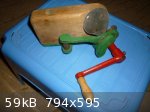
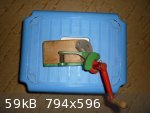
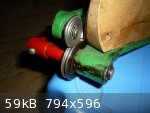
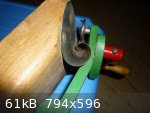
|
|
|
dss
Oud Lover
 
Posts: 11
Registered: 3-15-2005
Location: NY
Member Is Offline
Mood: No Mood
|
|
A vote for can or maybe oud case opener.... ;-)
|
|
|
antekboodzik
Oud Junkie
    
Posts: 109
Registered: 5-24-2010
Location: north poland
Member Is Offline
|
|
 No, i think it isn't. But at first sight I was thinking it is something to use
in the kitchen. No, i think it isn't. But at first sight I was thinking it is something to use
in the kitchen.
Anyway. it looks like it was designed to insert something via this metal "scroll" and and "squezee" between these two wheels, the smaller one is
pushed towards the bigger one with groove. Maybe for compacting fibres into a cord? But it seems to be too small.
|
|
|
abc123xyz
Oud Junkie
    
Posts: 114
Registered: 5-17-2007
Member Is Offline
Mood: No Mood
|
|
Well if this is a Luthier's tool (Is it confirmed that this is a Luthier's tool?), the only use I can imagine for it is bending fret wire.
David
|
|
|
abc123xyz
Oud Junkie
    
Posts: 114
Registered: 5-17-2007
Member Is Offline
Mood: No Mood
|
|
Did we ever find out what this tool is for? :·)
David
|
|
|
Dr. Oud
Oud Junkie
    
Posts: 1370
Registered: 12-18-2002
Location: Sacramento, CA, USA
Member Is Offline
Mood: better than before
|
|
Not a fret wire bender, frets have a tang to hold in the fingerboard, which would be deformed by the wheel. Not a can or case opener, because the
feeding funnel would prevent feeding any flat sheet into the press. The only thing I can see to use it for is to form a U shape in a flat strip of
metal. This could be used for edging or other metalwork. I can not imagine any use in a lutherie shop.
|
|
|
jdowning
Oud Junkie
    
Posts: 3485
Registered: 8-2-2006
Location: Ontario, Canada
Member Is Offline
Mood: No Mood
|
|
I have an interest in old hand cranked devices but have never come across one like this. It is not substantial enough or of the correct design to form
thin metal strips into a U section.
So what can be learned of its intended function from its appearance?
1) it is a manufactured product - relatively modern.
2) the funnel feeding the rolls is designed to provide a twist and compression to the input material before passing through the rolls.
3) the rolls are designed to pull the material from the funnel in a straight line guided by the U shaped bottom roll - the free rolling, spring loaded
top roll providing the necessary friction.
The material drawn though the machine would have to be strong but easily formed into a permanent shape but what was it?
My guess is paper.
Paper twist is a kind of rope or string made by twisting lengths of paper - compressed from a width of about 4 inches (10cm) before being twisted into
a relatively uniform cylindrical string - an imitation of 'Raffia' a natural fibre .
The attached images show examples of commercially available 'paper twist' that not only has a utilitarian use for tying stuff together but is also a
base material for a popular modern craft - that of making decorative paper flowers and other objects.
So, the proof test of this theory would be to take a wide strip of strong, thin kraft paper, feed it into the funnel, crank the handle and see what
comes out the other end!
|
|
|
jdowning
Oud Junkie
    
Posts: 3485
Registered: 8-2-2006
Location: Ontario, Canada
Member Is Offline
Mood: No Mood
|
|
By way of comparison and for general information, the attached images are of a hand cranked machine that is designed for forming grooves in thin metal
(0.4 mm thick). Much heavier in construction than the mystery machine and with geared rolls. It is one of my antique tinsmithing machines called a
turning machine. Usually used for turning over the top edge of a tinplate cylinder - such as a cup or tankard - prior to inserting and enclosing a
wire reinforcement.
I have not made historical tinware for a few years now but here is my tinsmith shop and a few examples of my work - all made by hand with the
assistance of traditional hand cranked machines. The machines were American inventions of the mid 19th C designed to speed up the fabrication work.
One day I plan to make an oud entirely in tinplate (as I have already done for a guitar) - just for fun.
http://www.mikeouds.com/messageboard/viewthread.php?tid=8565#pid557...
[file]30121[/file] [file]30123[/file] [file]30125[/file]
|
|
|
antekboodzik
Oud Junkie
    
Posts: 109
Registered: 5-24-2010
Location: north poland
Member Is Offline
|
|
Dear jdowning,
your assumption is right  I recently saw similar device in a local flower shop,
but I totally forgot I was asking about it here. It is used to make decorative "bouquets" with "roped" edges from blotting-paper... And the lady in
that particular shop told me she got her device from Italy, and she had never known a specific name for it. I recently saw similar device in a local flower shop,
but I totally forgot I was asking about it here. It is used to make decorative "bouquets" with "roped" edges from blotting-paper... And the lady in
that particular shop told me she got her device from Italy, and she had never known a specific name for it.
However, thank you for your interest, and for interesting comments (as usual)  One thing I could add, that is there is a sketch-information about so-called "prunk laute" on Steven Barber's website: http://www.lutesandguitars.co.uk/htm/cat01.htm
One thing I could add, that is there is a sketch-information about so-called "prunk laute" on Steven Barber's website: http://www.lutesandguitars.co.uk/htm/cat01.htm
I wonder you have got more information about that instrument. Please share, it would be welcome.
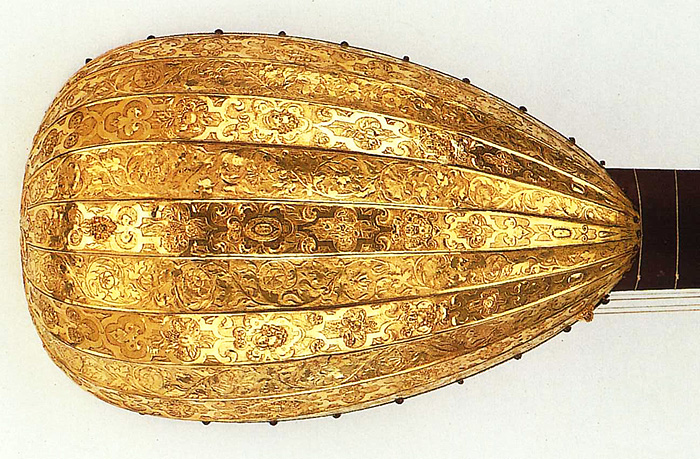
|
|
|
jdowning
Oud Junkie
    
Posts: 3485
Registered: 8-2-2006
Location: Ontario, Canada
Member Is Offline
Mood: No Mood
|
|
Thanks antekboodzik - glad that the mystery has been resolved!
I rarely visit Stephen Barber's site so was unaware of the existence of this interesting 'Prunkt' lute, subject as it is to such scorn by Barber and
Harris. Clearly with its ebony sound board it was never intended to be played as a lute and is just a decorative work of art - a display of the
craftsman's metal working skills. Of the instrument in question I have no further detail.
It is no surprise that this artifact is heavy compared to a real lute, copper being about 8X 'heavier' (specific gravity) than say a dense tropical
hardwood used to make a lute bowl. However, a bowl fabricated from metal can be made much thinner than one made of wood and still have the required
strength under string tension as one made of wood - so the weight difference between a wooden and metal bowl need not be so pronounced. Metal, being
more malleable than wood also offers the interesting possibility of the ribs of the bowl being made heavily fluted.
So here is an interesting challenge - to build a lute not completely in metal (as I did with my tinplate guitar) but with a thin fabricated metal bowl
and the rest of the instrument - sound board, neck, pegbox etc. in conventional wood construction. An instrument designed to be played!
When I can get around to it I will report on progress with the project as a separate topic on the forum.
|
|
|